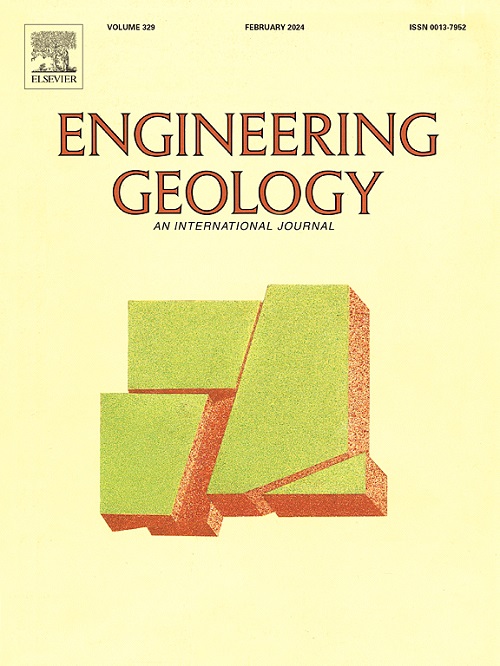Seasonal dynamics of root growth and desiccation cracks and their effects on soil hydraulic conductivity
IF 6.9
1区 工程技术
Q1 ENGINEERING, GEOLOGICAL
引用次数: 0
Abstract
Vegetation significantly influences soil hydraulic conductivity, with the extent of this influence depending on root morphology and density, which vary across different developmental stages of plants. This research investigates the interaction dynamics between plant roots (during both growth and decay) and desiccation cracks, as well as the combined impact of vegetation, cracks, and seasonal variations on soil hydraulic conductivity (Ksat). Root growth and decay patterns were observed using a minirhizotron, while changes in crack formation were monitored and interpreted using the Crack Intensity Factor (CIF) for both vegetated and bare areas over an eighteen-month period of wetting and drying cycles. Ksat was analysed based on data from a double-ring test. The findings indicate that the presence of vetiver roots results in a less visible and uneven crack distribution compared to bare soil, with CIF and average crack widths reduced by half. However, cracks reappear during root decay periods. Although cracks were minimised in vegetated soil, Ksat values increased significantly during dry periods, with a 16-fold rise in the vegetated zone due to root propagation, while the bare zone showed a marginal 5-fold increase. The presence of cracks and roots significantly influences Ksat, exhibiting distinct hysteresis behaviour in response to drying and wetting cycles.

根系生长和干燥裂缝的季节动态及其对土壤导水性的影响
植被对土壤水导率有显著影响,影响程度取决于根系形态和密度,而根系形态和密度在植物的不同发育阶段有所不同。本研究探讨了植物根系(生长和腐烂过程中)与干裂之间的相互作用动态,以及植被、干裂和季节变化对土壤水力导电性(Ksat)的综合影响。在为期18个月的干湿循环中,研究人员使用微型微型加速器观察了根系的生长和腐烂模式,同时使用裂缝强度因子(CIF)监测和解释了植被区和光秃区裂缝形成的变化。Ksat是根据双环试验数据进行分析的。结果表明,与裸露的土壤相比,香根草根的存在导致裂缝分布不明显和不均匀,CIF和平均裂缝宽度减少了一半。然而,裂纹在根腐蚀期间再次出现。尽管植被土壤的裂缝最小,但Ksat值在干旱期间显著增加,由于根系繁殖,植被区增加了16倍,而光秃秃的地区增加了5倍。裂缝和根系的存在显著影响Ksat,在干湿循环中表现出明显的滞后行为。
本文章由计算机程序翻译,如有差异,请以英文原文为准。
求助全文
约1分钟内获得全文
求助全文
来源期刊

Engineering Geology
地学-地球科学综合
CiteScore
13.70
自引率
12.20%
发文量
327
审稿时长
5.6 months
期刊介绍:
Engineering Geology, an international interdisciplinary journal, serves as a bridge between earth sciences and engineering, focusing on geological and geotechnical engineering. It welcomes studies with relevance to engineering, environmental concerns, and safety, catering to engineering geologists with backgrounds in geology or civil/mining engineering. Topics include applied geomorphology, structural geology, geophysics, geochemistry, environmental geology, hydrogeology, land use planning, natural hazards, remote sensing, soil and rock mechanics, and applied geotechnical engineering. The journal provides a platform for research at the intersection of geology and engineering disciplines.
 求助内容:
求助内容: 应助结果提醒方式:
应助结果提醒方式:


